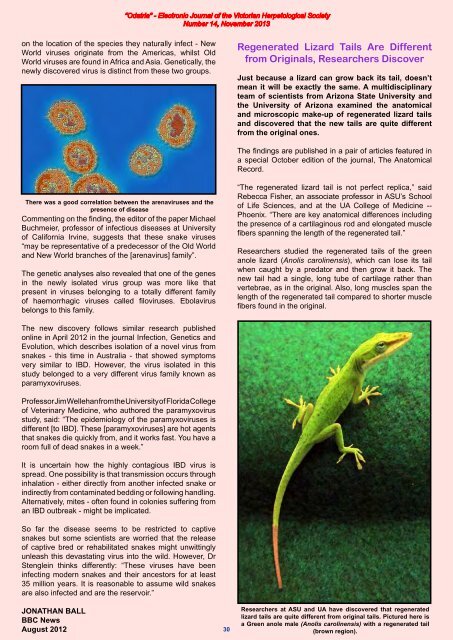Odatria_14_NOV13 - Victorian Herpetological Society
Odatria_14_NOV13 - Victorian Herpetological Society
Odatria_14_NOV13 - Victorian Herpetological Society
Create successful ePaper yourself
Turn your PDF publications into a flip-book with our unique Google optimized e-Paper software.
on the location of the species they naturally infect - NewWorld viruses originate from the Americas, whilst OldWorld viruses are found in Africa and Asia. Genetically, thenewly discovered virus is distinct from these two groups.Regenerated Lizard Tails Are Differentfrom Originals, Researchers DiscoverJust because a lizard can grow back its tail, doesn’tmean it will be exactly the same. A multidisciplinaryteam of scientists from Arizona State University andthe University of Arizona examined the anatomicaland microscopic make-up of regenerated lizard tailsand discovered that the new tails are quite differentfrom the original ones.The findings are published in a pair of articles featured ina special October edition of the journal, The AnatomicalRecord.There was a good correlation between the arenaviruses and thepresence of diseaseCommenting on the finding, the editor of the paper MichaelBuchmeier, professor of infectious diseases at Universityof California Irvine, suggests that these snake viruses“may be representative of a predecessor of the Old Worldand New World branches of the [arenavirus] family”.The genetic analyses also revealed that one of the genesin the newly isolated virus group was more like thatpresent in viruses belonging to a totally different familyof haemorrhagic viruses called filoviruses. Ebolavirusbelongs to this family.“The regenerated lizard tail is not perfect replica,” saidRebecca Fisher, an associate professor in ASU’s Schoolof Life Sciences, and at the UA College of Medicine --Phoenix. “There are key anatomical differences includingthe presence of a cartilaginous rod and elongated musclefibers spanning the length of the regenerated tail.”Researchers studied the regenerated tails of the greenanole lizard (Anolis carolinensis), which can lose its tailwhen caught by a predator and then grow it back. Thenew tail had a single, long tube of cartilage rather thanvertebrae, as in the original. Also, long muscles span thelength of the regenerated tail compared to shorter musclefibers found in the original.The new discovery follows similar research publishedonline in April 2012 in the journal Infection, Genetics andEvolution, which describes isolation of a novel virus fromsnakes - this time in Australia - that showed symptomsvery similar to IBD. However, the virus isolated in thisstudy belonged to a very different virus family known asparamyxoviruses.Professor Jim Wellehan from the University of Florida Collegeof Veterinary Medicine, who authored the paramyxovirusstudy, said: “The epidemiology of the paramyxoviruses isdifferent [to IBD]. These [paramyxoviruses] are hot agentsthat snakes die quickly from, and it works fast. You have aroom full of dead snakes in a week.”It is uncertain how the highly contagious IBD virus isspread. One possibility is that transmission occurs throughinhalation - either directly from another infected snake orindirectly from contaminated bedding or following handling.Alternatively, mites - often found in colonies suffering froman IBD outbreak - might be implicated.So far the disease seems to be restricted to captivesnakes but some scientists are worried that the releaseof captive bred or rehabilitated snakes might unwittinglyunleash this devastating virus into the wild. However, DrStenglein thinks differently: “These viruses have beeninfecting modern snakes and their ancestors for at least35 million years. It is reasonable to assume wild snakesare also infected and are the reservoir.”JONATHAN BALLBBC NewsAugust 201230Researchers at ASU and UA have discovered that regeneratedlizard tails are quite different from original tails. Pictured here isa Green anole male (Anolis carolinensis) with a regenerated tail(brown region).


